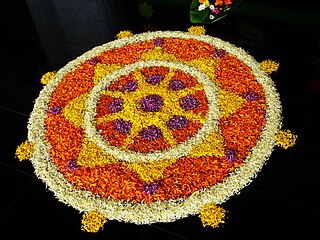
Onam is an annual harvest and cultural festival related to Hinduism that is celebrated mostly by the people of Kerala. A major annual event for Keralites, it is the official festival of the state and includes a spectrum of cultural events.
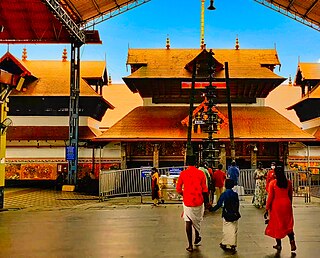
GuruvayurIPA:[guɾuʋɐːjuːr]) is a municipal temple town in Thrissur district, of Kerala State in India. It is a suburban town of Thrissur city, located 27 kilometres (17 mi) from Thrissur towards the north-west. It houses the Guruvayur Shri Krishna Temple. It is located at a distance of 292 km (181 mi) from the state capital Trivandrum towards the north-west, 80 km (50 mi) from Kochi towards the north, 90 km (56 mi) from Calicut towards south.
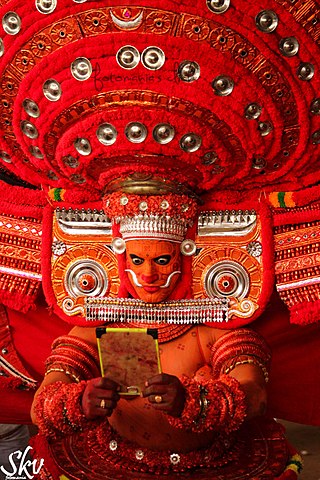
Theyyam is a Hindu religious ritual practiced in northern Kerala and some parts of Karnataka. Theyyam is also known as Kaḷiyāṭṭaṁ or Tiṟa. Theyyam consists of traditions, rituals and customs associated with temples and sacred groves of Malabar. The people of the region consider Theyyam itself as a channel to a god and they thus seek blessings from Theyyam.

Guruvayurappan also rendered as Guruvayoorappan, is a form of Vishnu worshipped mainly in Kerala, India. He is the presiding deity of the Guruvayur Temple, who is worshipped as Krishna in his child form, also known as Guruvayur Unnikkannan. The temple is located in the town of Guruvayur, Thrissur, Kerala, which is named after the deity.

The Guruvayur Temple (Gurupawanapuri) a famous Indian Hindu temple located in the town of Guruvayur in Thrissur district, Kerala. The temple is dedicated to Lord Vishnu (Guruvayurappan) but popularly known as Krishna. It is one of the most important places of worship for Hindus in Kerala and Tamil Nadu and is often referred to as Bhuloka Vaikuntha. The temple is Classified one among the 108 Abhimana Kshethram of Vaishnavate tradition.

Parassinikadavu Muthappan temple is a temple located at Parassinikadavu in Anthoor municipality on the banks of the Valapattanam river about 10 km (6.2 mi) from Taliparamba and 20 km (12 mi) from Kannur town in Kannur district, Kerala, India. Thiyya community urayima Principal deity of the temple is Sree Muthappan, whose divinity is presented as a ritualistic theyyam enactment in two versions called Thiruvappan and Vellattam. According to the local tradition the presiding deity is a manifestation of Lord Shiva.
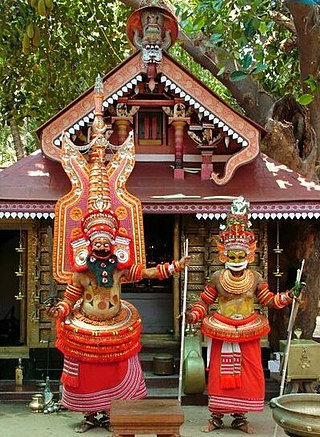
Muthappan is a deity commonly worshiped in the Kannur, Kasargod, Kozhikode, Malappuram region of Kerala and Coorg region of Karnataka in India. Muthappan is considered as the personification of two Hindu gods — the Thiruvappan or Valiya Muthapan (Vishnu) and the Vellatom or Cheriya Muthapan (Shiva).

Elephants found in Kerala, the Indian elephants, are one of three recognized subspecies of the Asian elephant. Since 1986, Asian elephants have been listed as endangered by IUCN as the population has declined by at least 50% over the last three generations, estimated to be 25,600 to 32,750 in the wild. The species is pre-eminently threatened by habitat loss, degradation and fragmentation. Along with a large population of wild elephants, Kerala has more than seven hundred captive elephants. Most of them are owned by temples and individuals. They are used for religious ceremonies in and around the temples, and some churches, and a few elephants work at timber yards.

Bhadrakali is a Hindu goddess. She is considered to be the auspicious and fortunate form of Adi Shakti who protects the good, known as bhadra.

The culture of Kerala has developed over the past millennia, influences from other parts of India and abroad. It is defined by its antiquity and the organic continuity sustained by the Malayali people. Modern Kerala society took shape owing to migrations from different parts of India and abroad throughout Classical Antiquity.
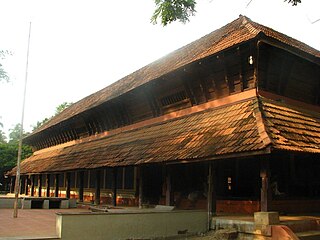
Punnathurkotta is a fort and former palace located in Kottapadi, about 3 km from the Guruvayoor Sree Krishna Temple, in Thrissur District of Kerala State in South India.

Thrikkakara Vamanamoorthy Temple is one of the major Hindu temples in India dedicated to Vamana, a form of the god Vishnu. It is situated in Thrikkakara, Kochi in the state of Kerala, India. The temple is around two millennia old and is also listed as one of the 108 Divya Desams.

Gajarajan Guruvayur Keshavan is perhaps the most famous and celebrated temple elephant in Kerala, India. He was donated to the Guruvayur temple by the royal family of Nilambur on 4 January 1922.

M R D Dattan was a famous artist and sculptor in the state of Kerala, India. Dattan's works include statues of Mahatma Gandhi, Swami Vivekananda and Sree Narayana Guru. He had created more than 200 statues of Sree Narayana Guru alone.

Hinduism is the largest religion in Kerala and Hindu lineages together make up 54.8% of the population of the state according to the 2011 census.

Thottam Pattu is a ballad sung just before performing the Theyyam ritual. These are played in Theyyam temples before the commencement of Theyyam Art. Thottam Pattu is invocative. This is a mythological belief that by performing this ritual, the performer will be possessed by divine spirits. Thottam Pattu, the ritualistic songs which accompany the performance elaborate the legends related to the deities. Percussions such as Chenda and Thudi accompany the songs. Usually drummer men or make-up men or both of them perform the Thottam pattu by singing during the make-up.

Peruvanam Kuttan Marar is a chenda artist. He leads several popular traditional orchestra performances in Kerala. He received Padma Shri, India's third highest civilian award, in 2011 for his contributions in the field of art.
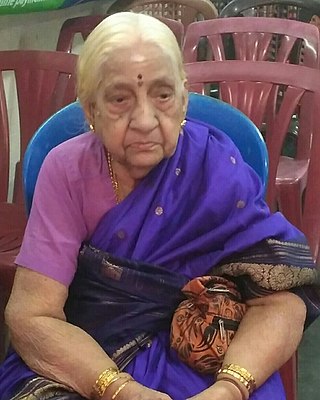
Parassala B. Ponnammal was an Indian Carnatic musician from the south Indian state of Kerala. She was a classical carnatic vocalist in the lineage of Semmangudi Srinivasa Iyer, Muthiah Bhagavathar, and Papanasam Sivan. She was the first woman to perform at the Navaratri Mandapam in Thiruvananthapuram as a part of the Navaratri Celebrations of the Sri Padmanabhaswamy temple in Kerala.
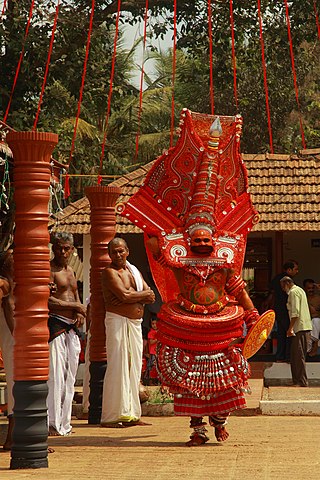
Poomaruthan Theyyam is a Hindu god popular in the North Malabar region of Kerala, India. This theyyam is performed in the shrines of the regional Hindu goddess Poomala bhagavathy. Poomala and Poomaruthan are worshiped mainly by the Thiyya community. The main temples where this theyyam is performed are spread over Kannur and Kasaragod districts.
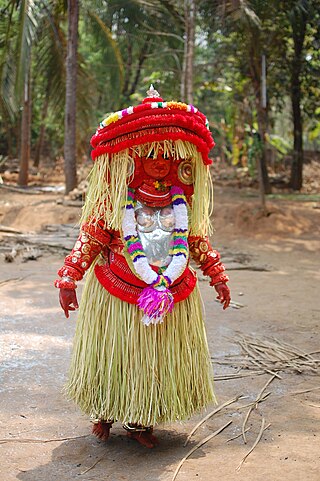
Uchitta Bhagavathy is a regional Hindu goddess worshipped in the North Malabar region in Kerala, India. Uchitta is worshiped and performed as Theyyam form. The main temples of this deity are spread over Kannur and Kasaragod districts in Kerala.






















